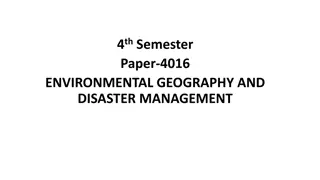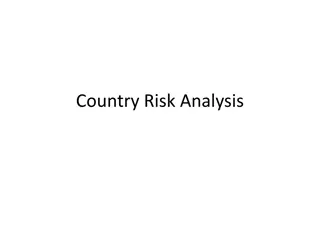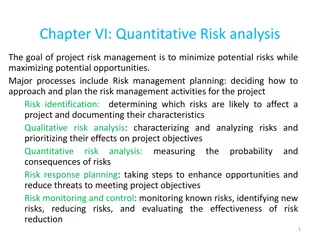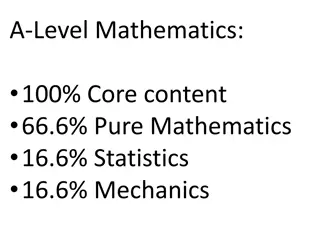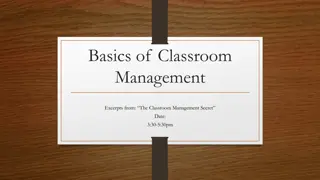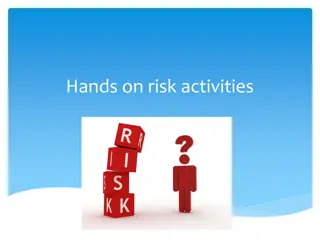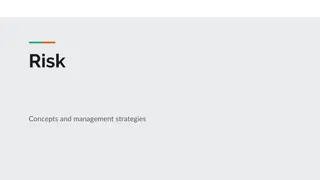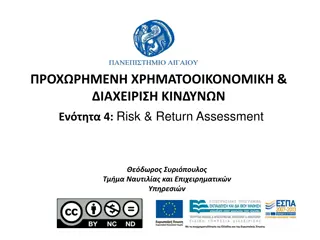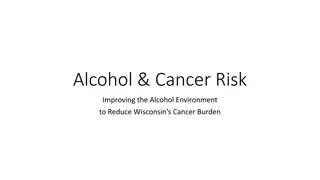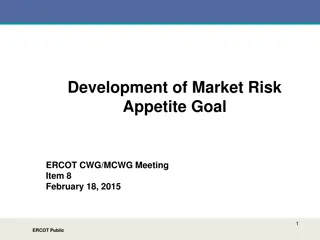Risk Concepts in the Mathematics Classroom
Risk is a concept integral to decision-making in various aspects of life. This resource explores how risk is defined in the real world, its relevance in the classroom, and strategies for teaching risk literacy to students. It delves into the multiple definitions of risk, risk analysis, and the emotional aspect of risk perception. Through this journey, educators can uncover misconceptions, engage students in critical thinking, and equip them with essential skills for navigating uncertainties in the modern world.
Download Presentation

Please find below an Image/Link to download the presentation.
The content on the website is provided AS IS for your information and personal use only. It may not be sold, licensed, or shared on other websites without obtaining consent from the author.If you encounter any issues during the download, it is possible that the publisher has removed the file from their server.
You are allowed to download the files provided on this website for personal or commercial use, subject to the condition that they are used lawfully. All files are the property of their respective owners.
The content on the website is provided AS IS for your information and personal use only. It may not be sold, licensed, or shared on other websites without obtaining consent from the author.
E N D
Presentation Transcript
A journey of risk Teaching concepts of risk within the Mathematics classroom
Agenda How is risk defined in the real world and how it can be explained in the classroom. The teaching cycle of risk and how it fits within the New Zealand curriculum. Risk literacy and useful critical questions What concepts about risk do the students bring into the classroom. What tasks can be used to uncover your students misconceptions and help teach risk. Really useful resources. Where to from here.
How risk is defined in the real world Risk is an awareness that we have developed to help us understand and cope with the dangers and perceived uncertainties of life where the threat to an outcome is unknown. Everyday people make decisions that are based on statistical information investments, insurance, product purchases, assessing tsunami risk, measuring the effects of changes to scheduling of transport services, political decisions and medical procedures. The definition of risk often depends in the industry or context in which it is being used.
How risk is defined in the real world One of the most common definitions of risk is as an uncertainty based on historical information. Risk can also be defined as a hazard, a probability, a variability of a probability, the possibility of occurring a misfortune or loss, or as a threat that requires exposure and uncertainty. The fact that risk can have so many meanings often causes problems in communication
How risk is defined in the real world Risk analysis Expressed in mathematical terms a risky event is one associated with a probability of a loss of recourses like health, time, food or money (Martigon, 2014). All risk decisions have the basic elements of options, outcomes and uncertainties set in a social context and framed in a language that highlights some of the ways of looking at the question (Fischoff and Kadvany, 2011).
How risk is defined in the real world Risk analysis Risk analysis is the need to quantify risk and is usually written in numerical terms. This is what the Mathematics Curriculum has introduced at Level 2. Risk analysis brings reason and scientific deliberation to risk management.
How risk is defined in the real world Risk as a feeling The intuitive reaction to danger, often automatic, nonverbal and an experimental approach to viewing risk. Even though decisions are based on statistical information there is an emotional element that means risk is subjective. People bring their world knowledge, personal disposition and interpretation of probability related statements as well as their ability to understand, manipulate or critically analyse information when it comes to risk.
How risk is defined in the real world Risk as a feeling the four biases Optimism bias belief that one s own risk is lower than the risk faced by others sharing the same behaviour. Risk denial learnt cognitive skill, strengthened by past and peer experiences where new evidence only appears reliable if it is consistent with a person s belief.
How risk is defined in the real world Risk as a feeling the four biases Anchoring bias the human tendency to rely on one (often irrelevant) piece of information when making decisions. Risk aversion where losses loom larger than gains. People will often take greater gains to avoid little losses while neglecting strategies to maximise long term gains.
The communication of risk The communication of risk is important in society as a two way exchange of information leads to the empowerment of individuals through better understanding and autonomy when making decisions. Poor communication could be lead to poor decisions, denial of the right to know and to participate in society and it can erode the goodwill and trust society needs to operate.
The communication of risk An example of poor communication and understanding of risk In October 1995 there was a contraceptive pill scare in Britain, when it was shown that there was a 100% increase of potentially life-threatening blood clots for women taking a new contraceptive, when in reality the risk went from 1 in 7000 to 2 in 7000. The estimated fallout from the scare was an estimated additional 13 000 abortions, an increase of 800 pregnancies in girls under 16 and an additional 46 million in health services as well as a drop in confidence with oral contraception.
The communication of risk General misunderstandings Can be due to several reasons cognitive limitations and biases or personal factors such as culture or health. The provider of information can choose the method of communication that best suits its interests. The time frame for the risk is not identified or not the same period for the two groups being compared. When the reported risk is not the risk of the target audience.
The communication of risk General misunderstandings Humans intuitive perception of risk can also cause misunderstanding. People have an insensitivity to large numbers; the loss of a few seems important. For example the loss of life due to one off shootings seems more important than the larger numbers lost to shootings in a war. Peoples insensitivity to probability, where the outcome has a stronger effect on emotions than the numerical value. For example the perception of risk is higher for events that are uncontrollable, catastrophic or fatal.
The communication of risk General misunderstandings Humans intuitive perception of risk can also cause misunderstanding. Lastly the numerator in a numerical probability plays a part. 7 in 100 can be seen as a better chance than 1 in 10.
Verbal communication The way in which language is used to convey risk information. Has the potential to improve comprehension of risk, capturing a person's emotions and intuitions better than numbers. Potential weakness in the vagueness in the variability of the individual interpretation of probability statements. Usually framed in terms of a loss or a gain.
Verbal communication Misunderstandings Positive framing has more of an effect in persuading people to take risky treatment options. Loss framing considers the potential losses from not having a test and influences more people to take the appropriate test than positive framing would do. Loss framing also means consumers are more likely to adopt high-risk products and influences consumers positive mood about products.
Visual communication A way to support risk communication Visual displays have the advantage to be able to summarise data and reveal patterns that may go undetected. Certain graphs lend them themselves to specific tasks for example icons are used to show the number of people affected in a population. Eppler and Aeschimann (2009) suggest interactive visualisation may be better suited to risk communication than print or text formats.
Visual communication Misunderstandings Poor design and complexity or misinterpreted. They may discourage people from looking at important details. Clear and comprehensible explanations with any calculations need to accompany each graph.
Numerical communication The use of numbers to quantify the magnitude of risk. Precise and verifiable with the ability to convert from one format to another. The weakness is its lack of sensitivity to intuitions and peoples level of numeracy. The way in which risks are expressed mathematically can make a difference in the way risk is interpreted.
Numerical communication definitions Baseline risk numerical information that does not include the treatment or behaviour in question. In practice it is hard to find and depends on the population that is being studied. Absolute risk Looks at one category and uses the same formula as probability, where the number with the trait is divided by the total in the category.
Numerical communication definitions Relative risk the ratio of the absolute risks for two groups, one being the group with the characteristic of interest and the other being the baseline or comparison group. Shows how much bigger or small one risk is relative to another and often expressed as a multiple. Natural frequencies presented as large counted events classified into groups. Easier to interpret as this is the traditional way people process numerical information.
Numerical communication definitions Odds ratio When two odds are compared relative to each other. Analytically it is easier to work with than relative risk. Numbers needed to treat The number of people necessary to treat in order to prevent one more unwanted outcome. Risk reduction how many fewer people with the desired trait there are with the treatment than those without the treatment.
Numerical communication Misunderstandings Numeracy levels of the target audience, for example interchanging between fractions and percentage formats. Excluding information about the baseline (reference class). Humans often make decisions without the baseline information and can be avoided when natural frequencies are used. Humans have difficulty understanding small probabilities due to the rarity in which we experience them.
Numerical communication Misunderstandings Relative risk is used when persuasion is the goal. When relative risk is used the reference class may be different to the intended target. Confusion could be avoided with a mixture of absolute risk and natural frequencies along side relative risk. Risk from dramatic events tend to be overestimated while risk from undramatic events tend to be underestimated.
Risk in the classroom Risk is crucial in order for us to participate in the modern world, therefore training young students in the perception of risk has become fundamental in modern society. Traditional probability instruction in school has a tendency to be based on the probability axioms and mathematical calculations. For the majority of us, the situations that necessitate us to draw on probability knowledge will be those requiring judgements or interpretation, not calculation .
The teaching cycle of risk Risk intuitions preconceived ideas and bias that people bring with them about risk and probability. Presentation of risk communication all the different formats of risk communication that a person must be familiar with. Interpreting risk communication understanding where the numbers come from. Included is the ability to change the format of how risk is presented.
The teaching cycle of risk Conversing with risk communication being able to explain risk in different formats so that the receiver of information with very little understanding of risk communication understands the harms and benefits without being mislead. This is the hard part of the cycle to accomplish. Reasoning with risk asking relevant risk literacy questions (to come) about risk. This is a higher level thinking and leads to new intuitions about risk.
How risk fits into the New Zealand Curriculum Achievement standard S7-3 Calculates and interprets risk, selects baseline group, and calculates and interprets relative risk and writes a news clip reporting on findings. In a media article with text and/or table, identifies absolute risk, baseline group and relative risk, and for relative risk, identifies the two groups being compared; Identifies missing information and justifies why it is important to include this information; identifies whether risk applies personally and why.
How risk fits into the New Zealand Curriculum Currently the NZC is assessing at the interpretation of risk communication stage of the cycle on a small area of risk communication. While we have made great strides in teaching students about the numbers behind risk communication, the assessment of interpretation of risk communication has not been linked to student s intuitions or other formats of risk communication.
How risk fits into the New Zealand Curriculum There are two aspects of the curriculum that help build students understanding of risk concepts. Probability with the importance on interpretation and evaluation of the language including independence and conditional probabilities when stated in a social context. Numeracy skills a key feature in risk quantification and communication.
What should be taught to help the understanding of risk? It is important to teach students to translate probabilities into natural frequencies; especially conditional probabilities. This is because the size of harms and benefits become more transparent when expressed as natural frequencies. Students need to be made aware there are two types of errors.
Risk literacy A branch of Statistical literacy and in particular probability literacy. The minimum components of being risk literate are the main concepts like absolute risk and learning to live with uncertainty rather than more advanced topics such as variability. People need to recognise that there is no guarantee of zero risk, only risk that is more or less acceptable.
Risk literacy Probability literacy Dispositional elements Critical stance Beliefs and attitudes Personal attitudes regarding uncertainty and risk Knowledge elements Variation Randomness Independence Uncertainty Figuring probabilities Language Context Critical questions Gal (2002)
Critical questions Risk of what? The outcome to which the risk refers. Size matters and it should be expressed in absolute terms or the baseline information should be given. There are two types of errors false positives and false negatives. What is the frame? Time frames such as the next ten years are easier to understand than lifetime risk. Wording. Does it apply to me?
Risk of What? What is the baseline? Has information about the baseline been included? Are any harms and benefits being expressed in the same format? Is the risk in relative risk or absolute risk form? Can the be shown in different formats - visual and numerical?
What is the frame? Is the time frame stated? Are the time frames for the two risks I am comparing the same? What is the framing (wording) of the question? Is it a positive or negative frame? Is it a loss or gain frame?
Does it apply to me? To whom does the risk apply? Do I share the same characteristics as these people?
Student reasoning and conceptions Availability Heuristic Judgement is created on the availability or recall of information in the memory. Leads to sensible use of own contextual knowledge to judge reasons for likelihoods when the likelihoods of risks are given. On the other hand it could lead to errors in judgement when the likelihood of risks are estimated.
Student reasoning and conceptions Critical questions to ask when judging risk information Risk of what? The size of risk depends on the baseline was not taken into account when judging risk but mentioned when asked how to determine risk. Appropriate reasoning about risk communication depends on the format presented.
Student reasoning and conceptions Critical questions to ask when judging risk information What is the frame? Time frame is not considered when it was not given. Larger numbers influence a preference for a positive frame. A preference for risk expressed as a harm or benefit is not always evident in students.
Student reasoning and conceptions Critical questions to ask when judging risk information Does it apply to me? The relevant sample space is not taken into account unless it is given to the students when it comes to judgements about risk.
Student reasoning and conceptions Reasoning numerical with risk Estimating risk - Sense of the size of risk. Considered the content and consequence. Developed a sense of numbers associated with high and low risk. Personal control ideas tended to lead to disregard of universal sample space
Student reasoning and conceptions Reasoning numerical with risk Calculating risk Natural frequencies led to appropriate calculations. Proportions led to inappropriate calculations. Language of risk - Everyday language vs. probability language. Some perceived risk as having a negative connotation.
Student reasoning and conceptions Sample space Universal sample space All population units Tended to disregard when assessing risk. Conditional sample space Subset of population Used when thinking about risk applying to me. Conditioning on the event where the students conditioned the event on the population or it was assumed that the event was already underway.
Student reasoning and conceptions Sample space - Conditioning on the event
Teaching activities Define risk - what it might uncover The negative, everyday language associated with risk and how students define risk. Personal control over risk. Those that perceive that they have control see the risk as small. Critical questions. The risk of what? (The size of the risk). Does it apply to me? The time frame of the risk.
Teaching activities Falling Firearm assault Motor cycle accident Motor vehicle accident Pedestrian accident Stroke Smoking Suicide Natural forces (quakes etc.) Drowning Rank these risks On the right is a list of events that people could die from. Put the events in order from one to ten, where one carries the most risk and 10 the least risk.




